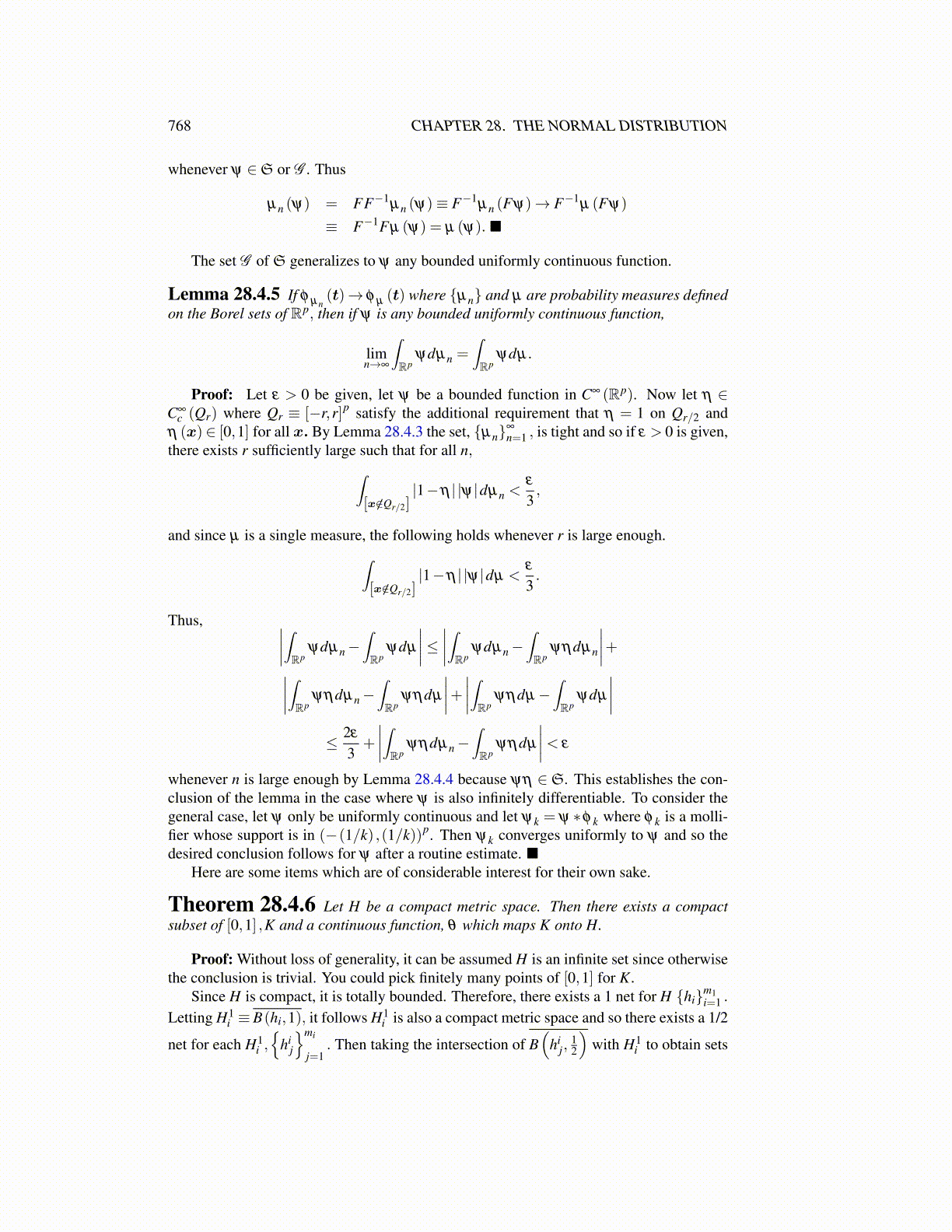
768 CHAPTER 28. THE NORMAL DISTRIBUTION
whenever ψ ∈S or G . Thus
µn (ψ) = FF−1µn (ψ)≡ F−1
µn (Fψ)→ F−1µ (Fψ)
≡ F−1Fµ (ψ) = µ (ψ). ■
The set G of S generalizes to ψ any bounded uniformly continuous function.
Lemma 28.4.5 If φ µn(t)→ φ µ (t) where {µn} and µ are probability measures defined
on the Borel sets of Rp, then if ψ is any bounded uniformly continuous function,
limn→∞
∫Rp
ψdµn =∫Rp
ψdµ.
Proof: Let ε > 0 be given, let ψ be a bounded function in C∞ (Rp). Now let η ∈C∞
c (Qr) where Qr ≡ [−r,r]p satisfy the additional requirement that η = 1 on Qr/2 andη (x)∈ [0,1] for all x. By Lemma 28.4.3 the set, {µn}
∞
n=1 , is tight and so if ε > 0 is given,there exists r sufficiently large such that for all n,∫
[x/∈Qr/2]|1−η | |ψ|dµn <
ε
3,
and since µ is a single measure, the following holds whenever r is large enough.∫[x/∈Qr/2]
|1−η | |ψ|dµ <ε
3.
Thus, ∣∣∣∣∫Rpψdµn−
∫Rp
ψdµ
∣∣∣∣≤ ∣∣∣∣∫Rpψdµn−
∫Rp
ψηdµn
∣∣∣∣+∣∣∣∣∫Rpψηdµn−
∫Rp
ψηdµ
∣∣∣∣+ ∣∣∣∣∫Rpψηdµ−
∫Rp
ψdµ
∣∣∣∣≤ 2ε
3+
∣∣∣∣∫Rpψηdµn−
∫Rp
ψηdµ
∣∣∣∣< ε
whenever n is large enough by Lemma 28.4.4 because ψη ∈S. This establishes the con-clusion of the lemma in the case where ψ is also infinitely differentiable. To consider thegeneral case, let ψ only be uniformly continuous and let ψk = ψ ∗φ k where φ k is a molli-fier whose support is in (−(1/k) ,(1/k))p. Then ψk converges uniformly to ψ and so thedesired conclusion follows for ψ after a routine estimate. ■
Here are some items which are of considerable interest for their own sake.
Theorem 28.4.6 Let H be a compact metric space. Then there exists a compactsubset of [0,1] ,K and a continuous function, θ which maps K onto H.
Proof: Without loss of generality, it can be assumed H is an infinite set since otherwisethe conclusion is trivial. You could pick finitely many points of [0,1] for K.
Since H is compact, it is totally bounded. Therefore, there exists a 1 net for H {hi}m1i=1 .
Letting H1i ≡ B(hi,1), it follows H1
i is also a compact metric space and so there exists a 1/2
net for each H1i ,{
hij
}mi
j=1. Then taking the intersection of B
(hi
j,12
)with H1
i to obtain sets